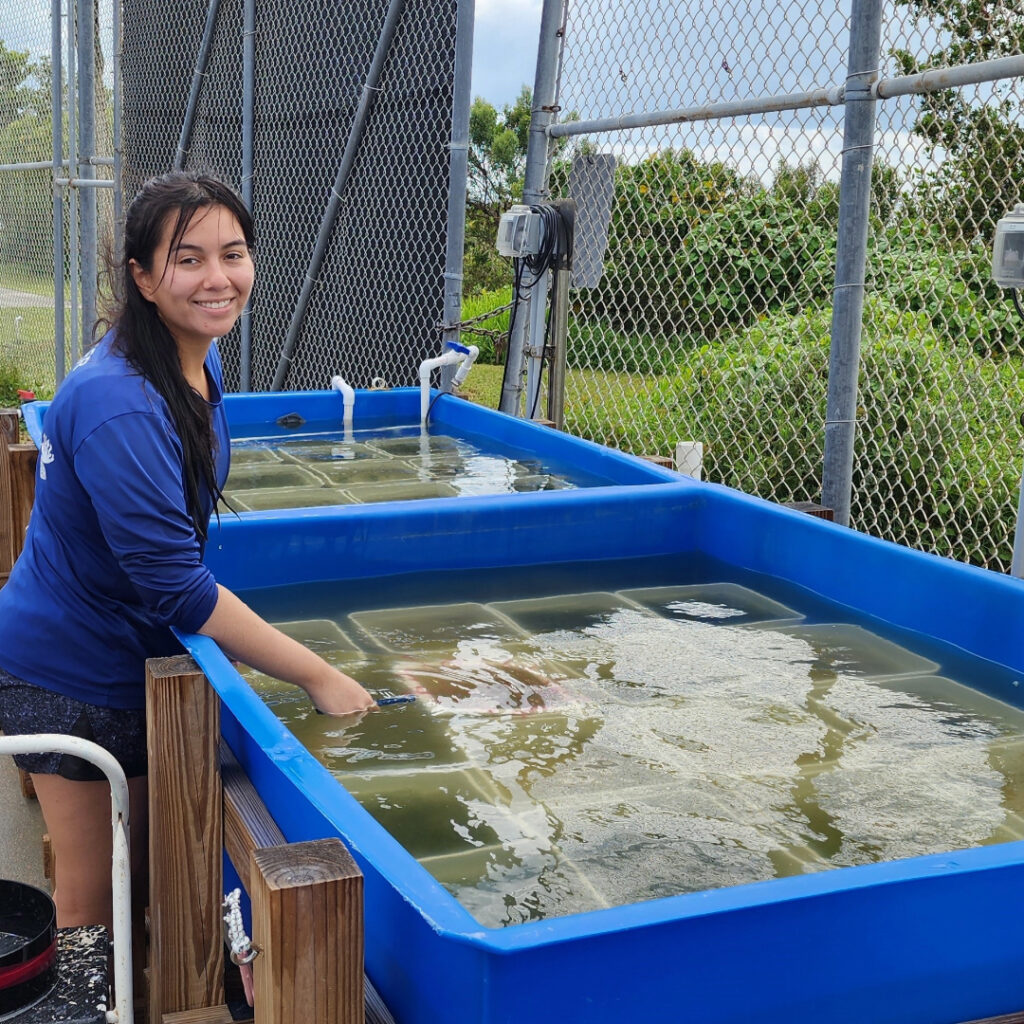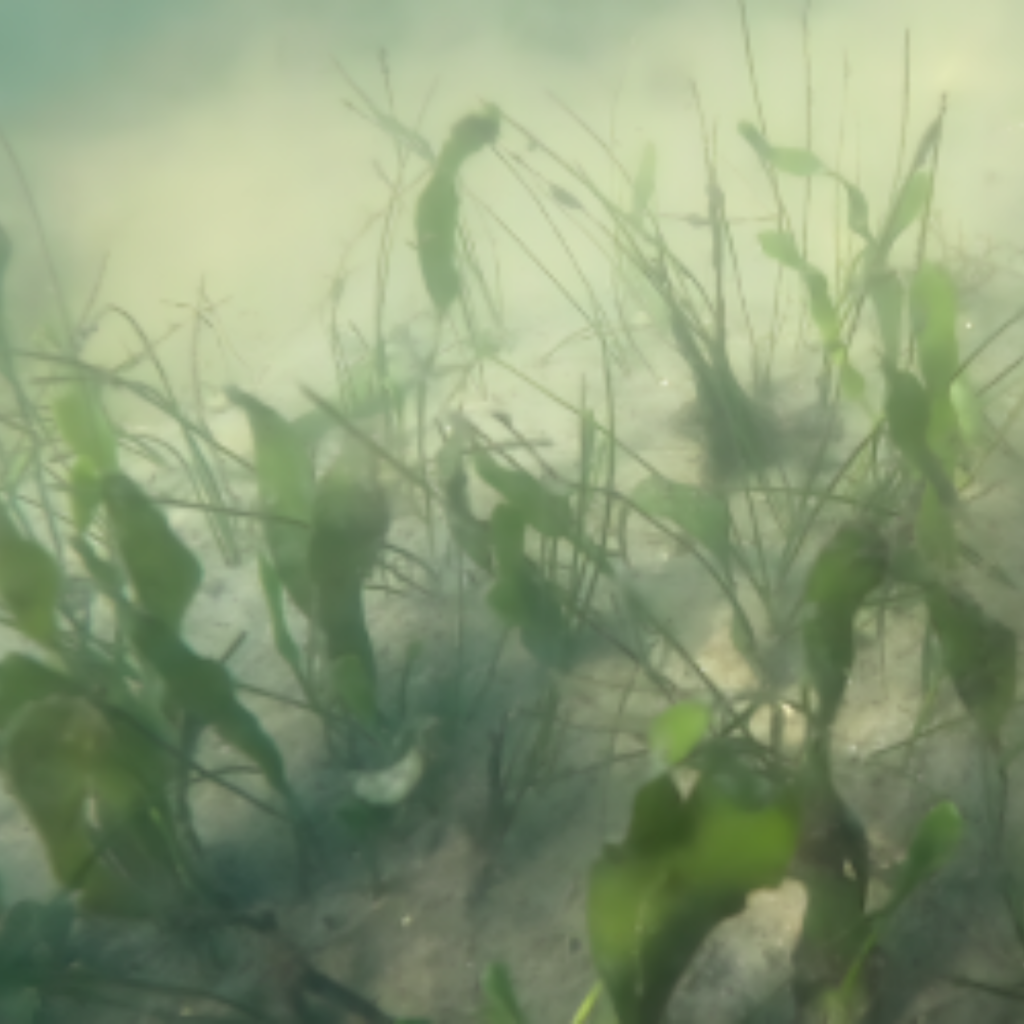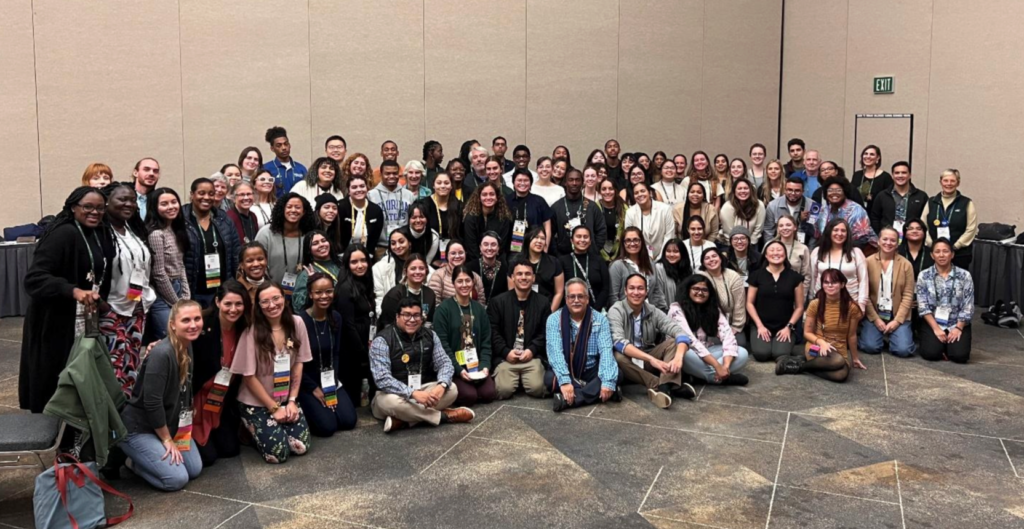
Banquero monitoring experimental tanks in Melbourne Beach, Florida. Photo Credit: Tom Emge.
Luciana Banquero is an M.S. student in the University of Central Florida’s Coastal & Estuarine Ecology Lab. She was awarded the Aylesworth Scholarship in 2024.
The Florida manatee (Trichechus manatus latirostris) has been my lifelong favorite animal. I find it incredible that our coastlines produce enough vegetation to feed thousands of manatees every year. Much of their diet consists of seagrass, which are marine plants that form lush underwater meadows. Seagrass coverage is in decline across its global range, posing a major threat to manatees and other animals that rely on these plants for food and shelter.
During my last year as an undergraduate, a Marine Mammal Unusual Mortality Event for the Atlantic Florida manatee was declared by the U.S. Fish and Wildlife Service due to a high number of malnutrition-related deaths. The Florida Fish and Wildlife Conservation Commission connected this to a “seagrass shortage” in the Indian River Lagoon, Florida, which is an important foraging location for manatees. This motivated me to study seagrass in graduate school to conserve and restore these habitats for the animals that rely on them.
My master’s thesis research at the University of Central Florida (UCF) focuses on improving coastal restoration of the seagrass Halodule wrightii, also known as shoal grass, with guidance from my mentors, Dr. Linda Walters and Dr. Melinda Donnelly. Shoal grass is the most abundant species of seagrass in the Indian River Lagoon, where my research is being conducted. Seagrasses are notoriously difficult to restore in part because their ecology is understudied. Thus, I set out to understand how shoal grass interacts with other environmental elements, of its environment with the goal of applying this knowledge to restoration.

A patch of seagrass, Halodule wrightii and Ruppia maritima, interspersed with C. prolifera in the northern Indian River, Florida, in 2024. Photo Credit: Luciana Banquero.
The Indian River Lagoon has recently experienced extensive blooms of Caulerpa prolifera, a seaweed that creates rooted beds in coastal sediments. Some of the seaweed C. prolifera beds grew within shoal grass restoration areas, making competition possible between these species. My study will test if shoal grass growth is influenced by the presence of C. prolifera within experimental tanks, and at multiple field sites in the Indian River Lagoon. I will examine growth metrics being examined including seagrass leaf growth and emergence of new leaves over time. I will also be comparing nutrient concentrations within sediments between areas with these species, which will provide insight into how resources are used by differing types of submerged aquatic vegetation.
The experimental tanks used for this study are part of the Brevard Zoo’s seagrass nursery facility at the Hubbs SeaWorld Research Institute in Melbourne Beach, Florida. This work would not be possible without the Brevard Zoo’s leadership and guidance, support from environmental scientists at St. Johns River Water Management District, the Aquatic Biogeochemistry Lab at UCF, the Fox Lab at the Florida Institute of Technology, and the Seagrass Restoration Technology Development Initiative for funding.
Preliminary results from the experimental tank suggest that shoal grass is not affected by C. prolifera in areas where coverage of the seaweed is sparse. However, dense coverage of C. prolifera may have a detrimental impact on shoal grass growth. This information, along with additional data to be collected, will help restoration practitioners decide which locations may be most suitable for planting shoal grass based on its abundance of C. prolifera.
My past three years as a marine scientist have brought about very exciting moments, including my experience as a participant in the Rising TIDES program with the Coastal and Estuarine Research Federation. This program has supported my travel to conferences to present my research, such as CERF’s 2023 Conference in Portland, Oregon, and the Restore America’s Estuaries Coastal and Estuarine Summit in Arlington, Virginia. Practicing my science communication skills at these conferences has pushed me to grow as a researcher.
These events have opened my eyes to the ocean of opportunities available to conservation professionals and students aspiring for a career in STEM, including those facilitated by Florida Sea Grant.
I am grateful to have been selected for an Aylesworth Scholarship in 2024 and encourage all interested students to apply. With support from the Aylesworth Foundation for the Advancement of Marine Science and the Florida Sea Grant College Program, I am better able to study interactions between the seagrasses and seaweeds of coastal Florida, contribute to restoration science, and become a part of the next generation of conservation professionals.

Banquero (5th from far left, standing) participates in the Coastal and Estuarine Research Federation’s 2023-2024 Rising TIDES Program Cohort. Also pictured are program mentors and SEAS Islands Alliance program participants. Photo Credit: Maryland Sea Grant.
Want to learn more about what Florida Sea Grant and the Aylesworth Scholarship has to offer? Visit our Student Opportunities page.